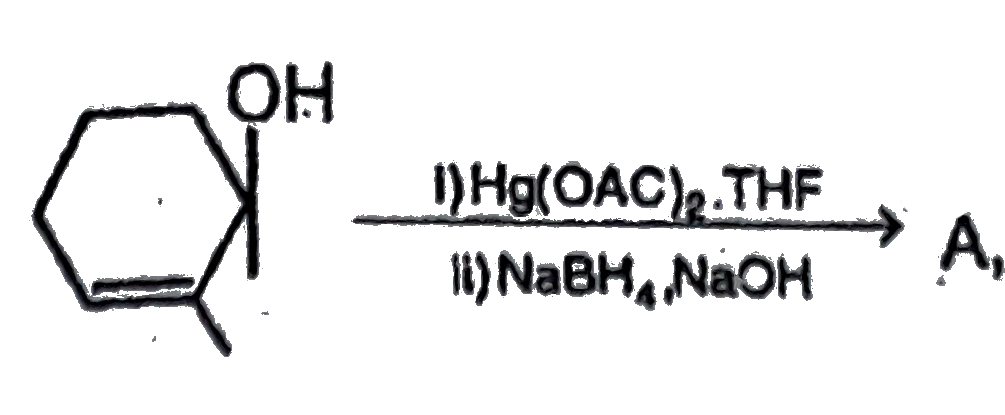which alkene does not follow Anti-Markownikoff's addition rule
2 - butene
1 - butene
2 - pentene
2 - hexene
The correct Answer is:A
To determine which alkene does not follow the Anti-Markovnikov's addition rule, we need to analyze the given options based on their structures. The Anti-Markovnikov addition rule applies to unsymmetrical alkenes, where the addition of HX (where X is a halogen) occurs in such a way that the hydrogen atom attaches to the carbon with more hydrogen atoms, and the halogen attaches to the carbon with fewer hydrogen atoms.
1. Identify the Options: We are given four options (A, B, C, D) which represent different alkenes. We need to analyze each one to see if it is symmetrical or unsymmetrical.
2. Analyze 2-Butene (Option A):
- Structure: CH3-CH=CH-CH3
- This alkene is symmetrical because both sides of the double bond are identical (both sides have CH3 groups).
- Conclusion: 2-butene does not follow the Anti-Markovnikov addition rule.
3. Analyze 1-Butene (Option B):
- Structure: CH2=CH-CH2-CH3
- This alkene is unsymmetrical because the two carbons involved in the double bond have different substituents (one has two hydrogens and the other has one hydrogen and a CH2 group).
- Conclusion: 1-butene follows the Anti-Markovnikov addition rule.
4. Analyze 2-Pentene (Option C):
- Structure: CH3-CH=CH-CH2-CH3
- This alkene is also unsymmetrical because the two carbons in the double bond have different substituents.
- Conclusion: 2-pentene follows the Anti-Markovnikov addition rule.
5. Analyze 2-Hexene (Option D):
- Structure: CH3-CH=CH-CH2-CH2-CH3
- This alkene is unsymmetrical as well, with different substituents on the double bond.
- Conclusion: 2-hexene follows the Anti-Markovnikov addition rule.
Final Conclusion:
The alkene that does not follow the Anti-Markovnikov addition rule is 2-butene (Option A), as it is symmetrical.
- Structure: CH3-CH=CH-CH3
- This alkene is symmetrical because both sides of the double bond are identical (both sides have CH3 groups).
- Conclusion: 2-butene does not follow the Anti-Markovnikov addition rule.
- Structure: CH2=CH-CH2-CH3
- This alkene is unsymmetrical because the two carbons involved in the double bond have different substituents (one has two hydrogens and the other has one hydrogen and a CH2 group).
- Conclusion: 1-butene follows the Anti-Markovnikov addition rule.
- Structure: CH3-CH=CH-CH2-CH3
- This alkene is also unsymmetrical because the two carbons in the double bond have different substituents.
- Conclusion: 2-pentene follows the Anti-Markovnikov addition rule.
- Structure: CH3-CH=CH-CH2-CH2-CH3
- This alkene is unsymmetrical as well, with different substituents on the double bond.
- Conclusion: 2-hexene follows the Anti-Markovnikov addition rule.
The alkene that does not follow the Anti-Markovnikov addition rule is 2-butene (Option A), as it is symmetrical.
Similar Questions
Knowledge Check
CH3−CH=CH−CH3HBr−−−−−−−−−−−−−−−−−−−−−−−→R2O2Δ(Anti-Markownikoff's addition)
Comment on optical activity of the products:ARacemicBDiastereomerCMesoDOptically pure enantiomerWhich of the following is an addition polymer ?
ANylonBMelamine formaldehyde resinCOrlonDPolystyrene
Discuss the mechanism of anti-Markownikoff addition of HBr to an unsymmetrical alkene.
View SolutionThe reaction of vinyl chloride with hydrogen iodide to give 1-chloro-1-iodoethane is an example of anti-Markownikoff's rule.
View SolutionAddition of mercuric acetate in the presence of water is called as oxymercuration.The adduct obtained gives alcohol on reduction with NaBH4 in alkaline medium.This is known as demercuration.Oxymercuration demercuration allows Markownikoff's addition of H, OH without rearrangement.The net result is the addition of H2O Answer the following question :

View SolutionAddition of mercuric acetate in the presence of water is called as oxymercuration.The adduct obtained gives alcohol on reduction with NaBH4 in alkaline medium.This is known as demercuration.Oxymercuration demercuration allows Markownikoff's addition of H, OH without rearrangement.The net result is the addition of H2O Answer the following question :

Product 'A'is :
View SolutionWrite short notes on the Markownikoff's rule
View SolutionWhich of the following alkenes will give anti-markownikoff's product as major product.
View Solution
